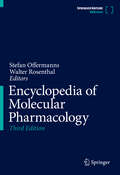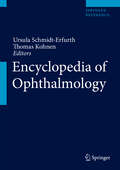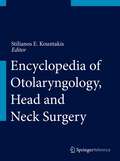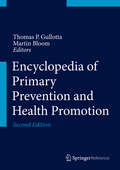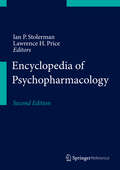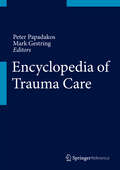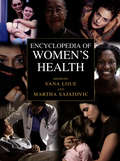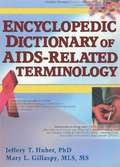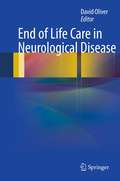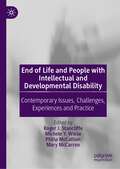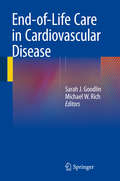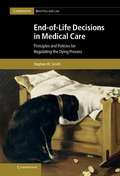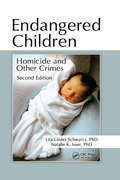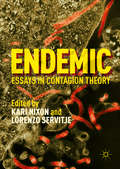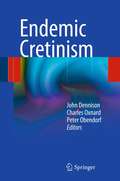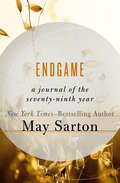- Table View
- List View
Encyclopedia of Molecular Pharmacology
by Stefan Offermanns Walter RosenthalAn essential text, this is a fully updated second edition of a classic, now in two volumes. It provides rapid access to information on molecular pharmacology for research scientists, clinicians and advanced students. With the A-Z format of over 2,000 entries, around 350 authors provide a complete reference to the area of molecular pharmacology. The book combines the knowledge of classic pharmacology with the more recent approach of the precise analysis of the molecular mechanisms by which drugs exert their effects. Short keyword entries define common acronyms, terms and phrases. In addition, detailed essays provide in-depth information on drugs, cellular processes, molecular targets, techniques, molecular mechanisms, and general principles.
Encyclopedia of Ophthalmology
by Ursula Schmidt-Erfurth Thomas KohnenRapid advances in pathogenetic insight, diagnostic and therapeutic modalities, and basic research continuously influence the state of the art in ophthalmology. This comprehensive encyclopedia offers a systematic and complete source of information including basic principles and novel updates, both clinical and scientific. The encyclopaedic format offers comprehensive access to focused information on all relevant topics in a clear and user-friendly manner. The spectrum ranges from short definitions, cross references, acronyms to disease chapters including epidemiology, symptoms and differential diagnosis, sections on diagnostic and therapeutic technologies, and comprehensive scientific summaries describing recent findings as well as results from relevant studies. The material is presented in a standardized, uniform and concise way throughout all clinical and academic sections. High-quality images highlight visual information and tables and graphs summarize important data. The encyclopaedia is available in book and electronic format which is linked to relevant ophthalmologic journals and is continuously updated. All chapters are authored by leading experts in the specific field. The target audiences are clinicians in ophthalmology and related specialties, researchers, and students.
Encyclopedia of Otolaryngology, Head and Neck Surgery
by Stilianos E. KountakisOtolaryngology Head and Neck Surgery is the medical and surgical specialty addressing disorders of the head and neck in both adult and pediatric populations. The goal of the encyclopedia is to serve as a single and comprehensive source of all the information that is essential for students and practitioners of the specialty. The vast amount of information included in the encyclopedia is divided into 5 volumes in line with the subspecialties of general otolaryngology, head and neck surgery, pediatric otolaryngology, otology-neurotology, and facial plastics. All volume editors are internationally recognized otolaryngologists with experience in publishing. Each section editor recruited experienced authors from all over the world to contribute on structured topics, and all entries are supported by published references. Thus, all information included in the encyclopedia is from credible sources and has been carefully screened for accuracy. The strength of the encyclopedia is its online availability and quick search features, which allow rapid retrieval of definitions and more in-depth information. Key words are hyperlinked to provide a gateway to numerous referenced manuscripts, journals, and books.
Encyclopedia of Primary Prevention and Health Promotion
by Thomas P. Gullotta Martin BloomEncyclopedia of Primary Prevention and Health Promotion
Encyclopedia of Psychopharmacology
by Ian P. Stolerman Lawrence H. PricePsychopharmacology is the study of the effects of psychoactive drugs on the functioning of the central nervous system at all levels of analysis, thus embracing cognition, behavior, psychological states, neurophysiology, neurochemistry, gene expression, and molecular biology. It includes, as an integral part of its domain, the interaction of environmental and genetic factors with psychoactive drug action, the medicinal and social uses of drugs, and the misuse and abuse of psychoactive substances. The aim of this comprehensive encyclopedia is to provide detailed information on psychopharmacology and its sub-disciplines, such as clinical psychopharmacology, molecular neuropsychopharmacology, behavioral pharmacology in laboratory animals, preclinical psychopharmacology, and human experimental psychopharmacology. The wide-ranging entries in the Encyclopedia of Psychopharmacology are written by leading experts drawn from a broad diversity of backgrounds and areas of specialization. The entries, comprehensive but succinct, provide basic and clinical scientists in academia, as well as industry, with the most important and relevant information on recent developments in psychopharmacology and its closely allied disciplines. The essential information about the field contained in these entries is readily accessible to clinicians, scholars, students, teachers, and interested laypeople.
Encyclopedia of Radiation Oncology
by Luther W. Brady Jay E. Reiff Reiner Class Stephan Mose Theodore YaegerThe aim of this comprehensive encyclopedia is to provide detailed information on radiation oncology. The wide range of entries are written by leading experts. They will provide basic and clinical scientists in academia, practice and industry with valuable information about the field of radiation oncology. Those in related fields, students, teachers, and interested laypeople will also benefit from the important and relevant information on the most recent developments.
Encyclopedia of Signaling Molecules
by Sangdun ChoiBiological processes are driven by complex systems of functionally interacting signaling molecules. Thus, understanding signaling molecules is essential to explain normal or pathological biological phenomena. A large body of clinical and experimental data has been accumulated over these years, albeit in fragmented state. Hence, systems biological approaches concomitant with the understanding of each molecule are ideal to delineate signaling networks/pathways involved in the biologically important processes. The control of these signaling pathways will enrich our healthier life. Currently, there are more than 30,000 genes in human genome. However, not all the proteins encoded by these genes work equally in order to maintain homeostasis. Understanding the important signaling molecules as completely as possible will significantly improve our research-based teaching and scientific capabilities. This encyclopedia presents 350 biologically important signaling molecules and the content is built on the core concepts of their functions along with early findings written by some of the world's foremost experts. The molecules are described by recognized leaders in each molecule. The interactions of these single molecules in signal transduction networks will also be explored. This encyclopedia marks a new era in overview of current cellular signaling molecules for the specialist and the interested non-specialist alike During past years, there were multiple databases to gather this information briefly and very partially. Amidst the excitement of these findings, one of the great scientific tasks of the coming century is to bring all the useful information into a place. Such an approach is arduous but at the end will infuse the lacunas and considerably be a streamline in the understanding of vibrant signaling networks. Based on this easy-approach, we can build up more complicated biological systems.
Encyclopedia of Sports Medicine
by Dr Lyle J. MicheliTo request a free 30-day online trial to this product, visit www.sagepub.com/freetrialWith an ever-growing variety of sports and exercise opportunities open to people of all ages, classes, and races, participation in casual sports has blossomed in recent decades, while interest in collegiate and professional sports has continued to soar. The field of sports medicine is thriving in response to the demand for health care professionals to care for people involved in vigorous exercise. Now more than ever, it is imperative that doctors, physical therapists, surgeons, nurses, and alternative medicine practitioners understand and are able to treat effectively the types of conditions stemming from all types of physical activity, ranging from pleasure walking to professional football. Presenting state-of-the-art research and evidence-based applications, this four-volume resource provides the most comprehensive and accessible information available on sports medicine. The Encyclopedia of Sports Medicine describes all aspects of the field with perspectives, concepts, and methods from the medical, behavioral, and social sciences and physical education.Key Features· Includes contributions from preeminent healthcare professionals who are renowned experts · Presents a broad spectrum of entries covering a variety of key topics, a glossary, and two appendices· Contains more than 550 tables and images, including anatomical drawings, X-rays, and MRI scans· Illustrates selected diagnostic and treatment techniques step-by-step with more than 200 photographs· Offers an in-depth examination of the various career opportunities in this area, including orthopedists, athletic trainers, sports psychologists, and nutritionistsKey Themes· Conditioning and Training· Diagnosis and Treatment of Sports Injuries· Diet and Nutrition· Doping and Performance Enhancement· Exercise Physiology, Biomechanics, Kinesiology· Injuries and Disorders· Injury Prevention· Medical Conditions Affecting Sports Participation· Rehabilitation and Physical Therapy· Special Populations· Specialties and Occupations in Sports Medicine· Sports and Society· Sports and Sports Medicine· Sports Psychology· Sports-Specific Injuries· Women and Sports
Encyclopedia of Thai Massage
by David Roylance C. Pierce SalgueroDrawing from Thai history, cultural studies, Buddhist religion, and yogic practices, as well as a modern understanding of anatomy and physiology, this guidebook bridges the gap between theory and practice while presenting bodywork as it is understood in Thailand-as a therapeutic medical science. Presenting detailed analysis of each step in a Thai massage routine, the history, spiritual traditions, and ethical codes are offered in an engaging, informal style. Numerous photographs and diagrams illustrate the variety of techniques used, and examples of routines for treating specific disorders are discussed. Updated with new layout, photos, and expanded text, this exhaustive handbook is complete with a section on the main energy meridians and diagrams of acupressure points, making it the perfect tool to accompany anyone studying this popular healing modality.
Encyclopedia of Trauma Care
by Peter J. Papadakos Mark L. GestringThis encyclopedia features practical information on major topics in trauma management. It covers the full range of organ-specific injuries as well as other important issues, including critical care, complications, and ethical issues.
Encyclopedia of Women's Health
by Martha Sajatovic Sana LoueDesignated a Reference Reviews Top Ten Print Reference Source 2005 The Encyclopedia of Women's Health meets this challenge by bringing together an impressive array of experts on topics from reproductive issues to gastrointestinal illnesses. This skilfully edited volume, informed by current health issues and health-care realities, offers readers practical information, historical aspects, and future directions, all meticulously researched and conveniently presented. Key features include: -Accessible A-to-Z coverage, including AIDS, birth control, hormone replacement therapy, teen pregnancy, sexual harassment, violence, body image, access to health care and more. -Entries spanning the medical, psychological, sociocultural, spiritual, and legal arenas. -Medical topics explored from both conventional and complementary perspectives. -Cross-cultural data illustrate issues as they apply to minority women, rural women, the elderly, and other underserved populations. -Special chapters on disparities in women's health and health care. -Historical overview of women in health - as patients and as professionals. -Suggested readings and resource lists.
Encyclopedic Dictionary of AIDS-Related Terminology
by Jeffrey T Huber Mary L GillaspyMake sense out of confusing HIV/AIDS terminology!Finally, here is a reference work that contains clear and useful definitions of words, phrases, and medical terms associated with HIV/AIDS! The Encyclopedic Dictionary of AIDS-Related Terminology is an easy-to-understand guide to all of the mainstream jargon surrounding this epidemic. This user-friendly volume brings you a number of essential features, such as: popular and scientific names of conditions and medicines listings of addresses and contact information for organizations and government agencies that are concerned with HIV/AIDS definitions of historical terms, abbreviations, and acronyms related to HIV/AIDS details of corporate and organizational involvement with HIV/AIDS research, prevention, and interventionThe Encyclopedic Dictionary of AIDS-Related Terminology also includes entries that describe and relate to legal, social, psychological, and religious issues, not just medical terms, to give readers a complete source that will meet all of their needs. With this single resource, you will be able to easily and thoroughly understand the sometimes complex jargon associated with HIV/AIDS. For librarians, AIDS service organizations, people living with AIDS, and the general public, the Encyclopedic Dictionary of AIDS-Related Terminology is a comprehensive guide to conditions and medical terms associated with HIV/AIDS. Dates, histories, addresses, telephone numbers, and Web site addresses are included with many entries.Including words specific to the epidemic as well as related psychosocial phrases, this essential volume offers you definitions of HIV/AIDS medications and listings of organizations and government agencies that are concerned with the disease.
End of Life Care for People with Dementia: A Person-Centred Approach
by Murna Downs Sarah Russell Jane Chatterjee Laura Middleton-GreenPeople with dementia need increasingly specialised support as they approach the end of life, and so too do their families and the professionals working with them. This book describes not only what can be done to ensure maximum quality of life for those in the final stages of the illness, but also how best to support those involved in caring for them. Emphasising the importance of being attuned to the experiences and needs of the person with dementia, the authors explain why and how they should be included in decisions relating to their end of life care. Practical strategies for ensuring physical and emotional wellbeing are provided, drawing on useful examples from practice and providing solutions to potential challenges that carers and family members will face. Dilemmas surrounding end of life care are explored in detail, including the moral dilemma of medical intervention, and the authors suggest ways of supporting family members through the process in terms of providing information, helping them adjust to change and loss, and involving them in their relative's care, and at how care staff can be supported through appropriate education and training, team building and information-giving. This is an essential resource for anyone who wishes to provide compassionate, person-centred care for a person with dementia as they approach the end of life, including care staff, nurses, social workers and related professionals.
End of Life Care in Neurological Disease
by David OliverAs end of life care is extended to more and more people it is increasingly important that people with progressive neurological disease are recognised as having particular issues as their disease progresses. This group of people with advancing motor neurone disease, multiple sclerosis, Parkinson's disease, multiple systems atrophy, progressive supranuclear palsy, Huntington's disease and other progressive neurological disease face increasing problems - with physical symptoms and psychosocial and spiritual issues for both themselves and their families and carers. This book encourages health and social care professionals to become closely involved in the care of these people and their families, so that advance care plans can be started and quality of life maintained. This book addresses the principles and practice of developing end of life care strategies for neurological disease, written with a clinical, multidisciplinary focus and illustrated with detailed case studies.
End of Life and People with Intellectual and Developmental Disability: Contemporary Issues, Challenges, Experiences and Practice
by Philip McCallion Roger J. Stancliffe Michele Y. Wiese Mary McCarronThis book on end of life examines how to include people with intellectual and developmental disability in the inevitability of dying and death. Comprising 17 chapters, it addresses challenging and under-researched topics including suicide, do-not-resuscitate, advance care planning, death doulas and accessible funerals. Topics reflect everyday community, palliative care, hospice and disability services.The book proposes that the rights of people with disabilities should be supported up to and after their death. Going beyond problem identification, the chapters offer positive, evidence-supported responses that translate research to practice, together with practice examples and resources grounded in lived experience. The book is applicable to readers from the disability field, and mainstream health professionals who assist people with disability in emergency care, palliative care or end-of-life planning
End-of-Life Care and Pragmatic Decision Making
by D. Micah HesterEvery one of us will die, and the processes we go through will be our own - unique to our own experiences and life stories. End-of-Life Care and Pragmatic Decision Making provides a pragmatic philosophical framework based on a radically empirical attitude toward life and death. D. Micah Hester takes seriously the complexities of experiences and argues that when making end-of-life decisions, healthcare providers ought to pay close attention to the narratives of patients and the communities they inhabit so that their dying processes embody their life stories. He discusses three types of end-of-life patient populations - adults with decision-making capacity, adults without capacity, and children (with a strong focus on infants) - to show the implications of pragmatic empiricism and the scope of decision making at the end of life for different types of patients.
End-of-Life Care in Cardiovascular Disease
by Sarah J. Goodlin Michael W. RichEnd-of-life issues in cardiology are becoming increasingly important in the management of patients in the cardiac unit, but there is frequently a lack of understanding regarding their impact on cardiology practice. The cardiac unit is increasingly becoming the location whereby a number of key clinical decisions relating to end-of-life care are being made, such as the decision to remove medications, the appropriate removal of cardiac devices, the management of do not resuscitate orders and the requirement for other cardiac procedures in light of the management of the terminally ill cardiac patients. Those working in palliative care need input from the cardiovascular team as the cardiologist is frequently still managing these patients until they are moved to the hospice. That this move into a hospice is often delayed until the very last moment, there is considerable onus on the cardiovascular management of these patients to be much broader in scope and take account of some of the more palliative medical decisions needed in this group of patients. This concise reference will detail the practical issues open to cardiovascular physicians and those medical professionals who manage patients reaching the end of their life from a cardiology perspective. It will detail the full management options open to them to ensure that their practice is in line with the requirements of the patient nearing the end of their life whether the cause be cardiovascular in origin or who need appropriate management of secondary cardiovascular symptoms. It will also include the various ethical, cultural and geographical issues that need to be considered when managing these patients.
End-of-Life Decisions in Medical Care
by Stephen W. SmithThose involved in end-of-life decision making must take into account both legal and ethical issues. This book starts with a critical reflection of ethical principles including ideas such as moral status, the value of life, acts and omissions, harm, autonomy, dignity and paternalism. It then explores the practical difficulties of regulating end-of-life decisions, focusing on patients, healthcare professionals, the wider community and issues surrounding 'slippery slope' arguments. By evaluating the available empirical evidence, the author identifies preferred ways to regulate decisions and minimise abuses at the end of life, and outlines an ethical theory which can provide practical guidance for those engaged in end-of-life decisions.
End-of-Life Nursing Care: A Guide For Best Practice
by Mrs Joanna De Souza Annie PettiferStudents and newly qualified staff make up much of the workforce delivering end-of-life care but, because end-of-life care can be both technically challenging and emotionally demanding, it is an aspect of nursing that can cause considerable anxiety. This very accessible, straightforward book helps to allay those concerns and enables pre-registration students to prepare confidently for the challenges they will face when they are caring for dying patients and supporting their families. Each chapter is based on a different and realistic scenario - reflecting a range of circumstances - to demonstrate the essential generic knowledge and skills they need to develop, and draws out the important practical and theoretical issues students should consider and address if patients and their families are to receive the best possible care. Written by two experienced palliative care lecturer/practitioners, and mapping closely to the NMC's 2010 domains, the book is tailored to the needs of student nurses working with adult patients. It explores the importance of their role in end-of-life care and how this interfaces with the roles of other multidisciplinary professionals involved in the care of their patients. It will also be helpful to students of other health-care professions and support newly-qualified health-care professionals working in adult health.
Endangered Children: Homicide and Other Crimes, Second Edition
by Lita Linzer Schwartz Natalie K. IsserFrom infancy onward, children are in danger from many sources, including parental and sibling abuse, drug abuse and mental illness in the home, parental neglect, and poverty. Removing an at-risk child from a troubled environment brings on a host of new concerns and is not always a panacea. Endangered Children: Homicide, and Other Crimes, Second Edi
Endemic
by Kari Nixon Lorenzo ServitjeThis book develops a new multimodal theoretical model of contagion for interdisciplinary scholars, featuring contributions from influential scholars spanning the fields of medical humanities, philosophy, political science, media studies, technoculture, literature, and bioethics. Exploring the nexus of contagion's metaphorical and material aspects, this volume contends that contagiousness in its digital, metaphorical, and biological forms is a pervasively endemic condition in our contemporary moment. The chapters explore both endemicity itself and how epidemic discourse has become endemic to processes of social construction. Designed to simultaneously prime those new to the discourse of humanistic perspectives of contagion, complicate issues of interest to seasoned scholars of science and technology studies, and add new topics for debate and inquiry in the field of bioethics, Endemic will be of wide interest for researchers and educators.
Endemic Cretinism
by Peter Obendorf John Dennison Charles OxnardResponding to a renewed interest in the growing problem of iodine deficiency worldwide, Drs. Charles Oxnard and Peter Obendorf, along with experienced translator and anatomist John Dennison, take a fresh look at the classic text, Der endemische Kretinismus, published in 1936 by Springer. Translated here for the first time into English, this landmark text will be a welcome resource for researchers confronting the problem of iodine deficiency. Oxnard and Obendorf point out that there is very little detailed knowledge or numerical data on cretinism available in the English-speaking world. In addition, highly-renowned Professor Basil S. Hetzel, recently-retired World Health Organization Chairman of the International Council for Control of Iodine Deficiency Disorders, published in 2009 with Dr Chen Zu-pei on the resurgence of iodine deficiency in China. Indeed, throughout the entire developing world there may be as many as two billion people at risk to iodine deficiency; perhaps three quarters of a billion have goiter, and ten million may be cretins. Even in developed countries, iodine deficiency is re-emerging (as in New South Wales in 19% of children) with the result of significantly reduced numbers of gifted children (though this is not cretinism per se). Certain to be of significant interest to a wide range of researchers, health providers and professionals, including government health administrators, this English translation of Endemic Cretinism is a major contribution to the literature.
Endemic Disease in China (Public Health in China #2)
by Dianjun SunThe book focuses on the iodine deficiency, endemic fluorosis, endemic arsenic poisoning, Kashin-Beck disease and Keshan disease which are five kinds of national key endemic diseases, a total of six chapters, comprehensively systematically introduces the information of five kinds of endemic diseases, including the epidemic characteristics, clinical manifestation, diagnosis standards, and the current control situation, preventive strategy, working experience, and successful control cases, etc.Endemic disease is confined to certain areas, of which there are dozens in Chinese inland, in which there are eight types been listed in the national key control endemic diseases. Endemic diseases are serious in China, and have wide distribution, weight illness and a large threatened population. China has made great achievements on the endemic diseases prevention and control, and also has accumulated rich experiences of the prevention and treatment, summed up some complete and effective preventive strategy, which based on the characteristics of endemic diseases epidemic and prevention work.Dr. Dianjun Sun is the Director of Center for Endemic Disease Control,Chinese Center for Disease Control and Prevention, Harbin, China. He is also a professor of Harbin Medical University, China.
Endgame: A Journal of the Seventy-Ninth Year
by May SartonAs she battles debilitating illnesses, May Sarton looks back on her life, cherishes new and old friendships, and finds hope in the brave new world of old age "I always imagined a journal that would take me through my seventy-ninth year," May Sarton writes, "the doors opening out from old age to unknown efforts and surprises." Instead of musing calmly on the philosophical implications of aging, the writer found herself spending most of her energy battling for her health. Coping with constant pain and increasing frailty, Sarton fears that the end is not far off. The story of what she calls the "last laps of a long-distance runner," this yearlong journal addresses such familiar Sarton topics as her beloved garden, the harshness of Maine winters, and the friendships and intimate relationships that have nurtured and sustained her. She settles some old literary scores and paints a generous portrait of Virginia Woolf, who often shared tea with Sarton during the late 1930s. When illness saps Sarton's ability to type, she dictates into recorders and has the tapes transcribed by devoted assistants. In spite of the loss of independence and the fear that she will never fully recover, she does her best to soldier on, taking pleasure in small things like a good meal; her cat, Pierrot, who loves the rain; and being able to sleep through the night. An enduring inspiration to millions of women, Sarton even finds the courage to achieve again.
